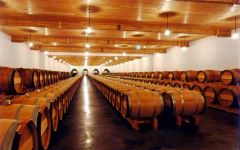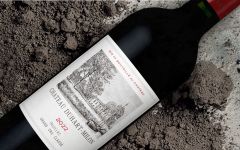Chateau Duhart-Milon 2017
-
James
Suckling - Decanter
-
Wine
Enthusiast -
Wine
Spectator -
Jeb
Dunnuck -
Robert
Parker -
Wilfred
Wong



Product Details
Your Rating
Somm Note
Winemaker Notes
Blend: 76% Cabernet Sauvignon, 24% Merlot
Professional Ratings
-
James Suckling
This is classical in style with lead pencil and sweet tobacco to the currant and plum undertones. Warm and cool at the same time. Full-bodied, tight and reserved with very polished, creamy tannins. It goes on and on. Compact, creamy texture. Try after 2023.
-
Decanter
A brilliantly elegant, suave Duhart, one of the successes of the appellation for me. This is a classically structured Duhart, a wine that is not overly exuberant but that has a sense of direction and balance, and is well held together. There's a very attractive quality to the tannins, joined by dark bilberry fruits that gain weight through the palate. It doesn't quite have the dense concentration and richness of 2016, but that was an exceptional vintage. This is a wine that I look forward to following as it ages. Around 5% frost on the northwest corner, affecting the Merlot for the second wine (not tasted). But overall the vintage was so early that even though the September rains probably brought alcohol levels down a touch, they did not unduly worry as the fruit was already ripe enough. 3.75pH. 50% new oak. 38hl/ha yield.
Barrel Sample -
Wine Enthusiast
This structured wine has the freshest fruit, crisp with black currants. The core of dryness is important, bringing out density to balance the light touch at the back of the wine. Drink from 2023
-
Wine Spectator
Features an alluring perfume, with singed alder, warmed currant preserve and smoldering bay leaf notes forming the core. Dark earth and mulled fig flavors fill in through the finish. A solid bolt of iron keeps everything moving in the same direction. Cabernet Sauvignon and Merlot. Best from 2022 through 2038.
-
Jeb Dunnuck
The 2017 Chateau Duhart-Milon is terrific, offering tons of Pauillac character in its smoked tobacco, blackcurrant, new leather, and spicy, earthy aromas and flavors. Rich, medium to full-bodied, and beautifully textured, it has the forward, elegant, classic style of the vintage and will continue drinking beautifully for 20-25 years or more. It’s a hidden gem in the vintage I’d be thrilled to have in the cellar.
-
Robert Parker's Wine Advocate
A blend of 76% Cabernet Sauvignon and 24% Merlot, the 2017 Duhart-Milon is beautifully scented of crushed red and black currants, black raspberries and spice cake with suggestions of lavender, cloves and rose hip tea. The palate is medium-bodied, very soft and elegant with seamless freshness and a lingering spiciness on the finish.
Barrel Sample: 89-91 -
Wilfred Wong of Wine.com
COMMENTARY: The 2017 Château Duhart-Milon is a classic and first-rate Pauillac. TASTING NOTES: This wine shines with aromas and flavors of black fruit with shading of oak. Enjoy it with BBQ beef kebabs. (Tasted: January 24, 2020, San Francisco, CA)
Other Vintages
2024-
James
Suckling -
Robert
Parker - Vinous
-
James
Suckling - Decanter
- Vinous
-
Jeb
Dunnuck -
Robert
Parker
-
Jeb
Dunnuck -
James
Suckling -
Robert
Parker - Decanter
-
Wine
Enthusiast - Decanter
-
James
Suckling -
Robert
Parker - Vinous
-
Jeb
Dunnuck
- Decanter
-
Robert
Parker -
Wine
Enthusiast -
James
Suckling -
Jeb
Dunnuck - Vinous
-
Wilfred
Wong
-
James
Suckling -
Wine
Spectator -
Robert
Parker - Decanter
-
Jeb
Dunnuck
-
James
Suckling - Decanter
-
Wilfred
Wong -
Wine
Enthusiast -
Robert
Parker -
Wine
Spectator -
Jeb
Dunnuck
- Decanter
-
James
Suckling -
Jeb
Dunnuck -
Wine
Enthusiast -
Wine
Spectator -
Robert
Parker
-
Wine
Enthusiast -
James
Suckling - Decanter
-
Robert
Parker -
Jeb
Dunnuck
-
Wine
Spectator -
Wine
Enthusiast -
James
Suckling - Decanter
-
Wine
Enthusiast -
James
Suckling -
Wine
Spectator
-
Wine
Spectator -
Wine
Enthusiast -
Wilfred
Wong -
James
Suckling -
Robert
Parker
-
Robert
Parker -
Jeb
Dunnuck -
Wine
Enthusiast -
James
Suckling -
Wine
Spectator
-
Robert
Parker -
Jeb
Dunnuck -
James
Suckling -
Wilfred
Wong -
Wine
Enthusiast -
Wine
Spectator
-
Robert
Parker -
Wilfred
Wong -
James
Suckling -
Wine
Enthusiast
-
Wine
Enthusiast
-
Wine
Enthusiast -
Robert
Parker
-
Robert
Parker -
Wine
Spectator -
Wine
Enthusiast
-
Robert
Parker
-
Robert
Parker -
James
Suckling -
Wine
Spectator
-
Wine
Spectator -
Robert
Parker
-
Wine
Spectator -
Robert
Parker
-
Robert
Parker
-
Wine
Spectator







In the early 18th century, Pauillac began widespread grape cultivation at the urging of the Lafite lords. The Milon wines served as additional income for Lafite’s master, and became Château Lafite’s second wine. The 1855 classification recognized the quality of Duhart-Milon’s soil by ranking it as the only 4th growth wine in Pauillac. Between 1830 and 1840, the Castéja family was left an inheritance by both Mandavy and the Duhart widow (35 acres). The family thus possessed a 99 acre vineyard that was named Duhart- Milon. The property changed ownership many times over the years and suffered a decline in the quality of its’ wines. The property was named after the Sieur of Duhart, gun-runner to Louis XIV, who originally owned the property, and from the name of the little hamlet of Milon which separates the Duhart-Milon vineyard from Château Lafite.
In 1962, Domaines Barons de Rothschild (Lafite) acquired the property from the Castéja family. Since the acquisition by Domaines Barons de Rothschild (Lafite) the vineyards have been totally overhauled and the chais renovated. A finishing touch to a remarkable 40 year effort to reclaim the Médoc 4th growth wine ranking for Château Duhart-Milon.

One of the world’s most classic and popular styles of red wine, Bordeaux-inspired blends have spread from their homeland in France to nearly every corner of the New World. Typically based on either Cabernet Sauvignon or Merlot and supported by Cabernet Franc, Malbec and Petit Verdot, the best of these are densely hued, fragrant, full of fruit and boast a structure that begs for cellar time. Somm Secret—Blends from Bordeaux are generally earthier compared to those from the New World, which tend to be fruit-dominant.

The leader on the Left Bank in number of first growth classified producers within its boundaries, Pauillac has more than any of the other appellations, at three of the five. Chateau Lafite Rothschild and Mouton Rothschild border St. Estephe on its northern end and Chateau Latour is at Pauillac’s southern end, bordering St. Julien.
While the first growths are certainly some of the better producers of the Left Bank, today they often compete with some of the “lower ranked” producers (second, third, fourth, fifth growth) in quality and value. The Left Bank of Bordeaux subscribes to an arguably outdated method of classification that goes back to 1855. The finest chateaux in that year were judged on the basis of reputation and trading price; changes in rank since then have been miniscule at best. Today producers such as Chateau Pontet-Canet, Chateau Grand Puy-Lacoste, Chateau Lynch-Bages, among others (all fifth growth) offer some of the most outstanding wines in all of Bordeaux.
Defining characteristics of fine wines from Pauillac (i.e. Cabernet-based Bordeaux Blends) include inky and juicy blackcurrant, cedar or cigar box and plush or chalky tannins.
Layers of gravel in the Pauillac region are key to its wines’ character and quality. The layers offer excellent drainage in the relatively flat topography of the region allowing water to run off into “jalles” or streams, which subsequently flow off into the Gironde.
